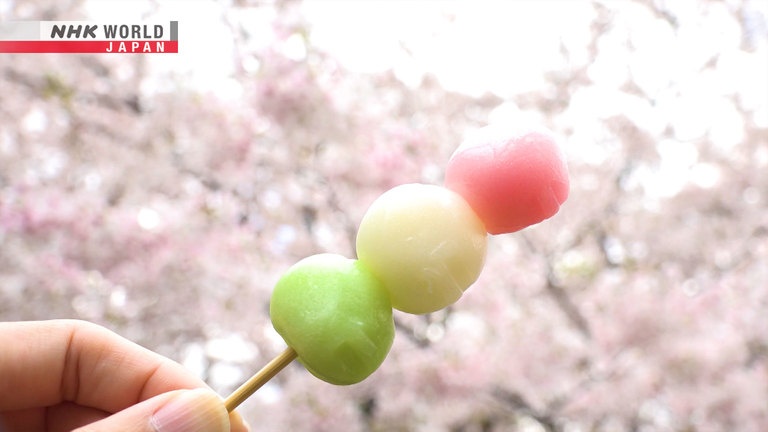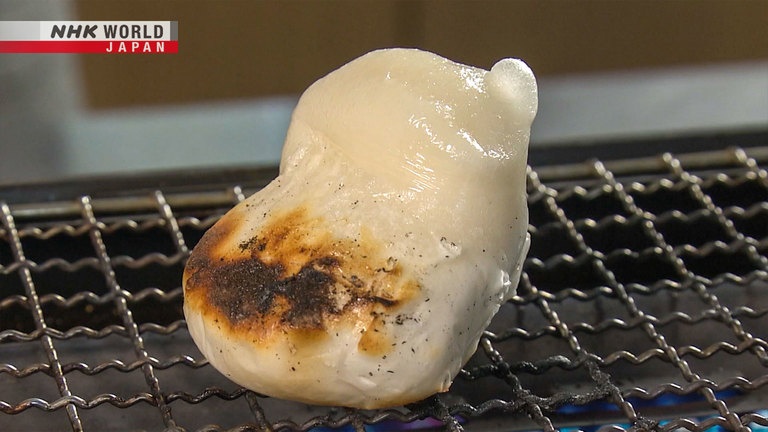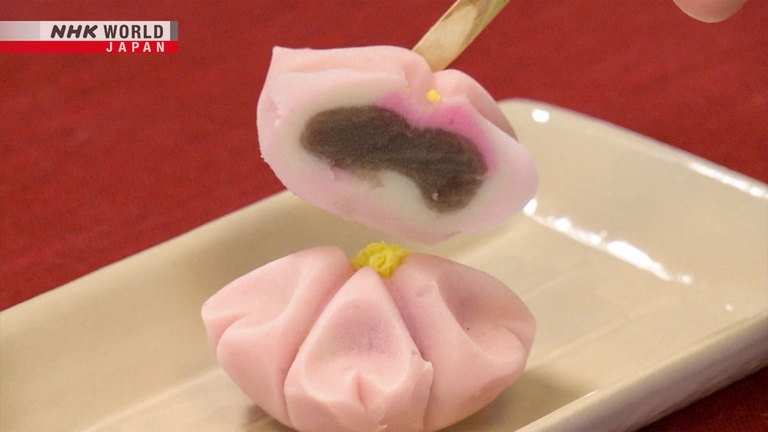Wagashi
The Japanese language is rich in words and expressions influenced by nature, history and culture. This episode introduces words related to wagashi, or Japanese sweets. Traditionally made to accompany the tea ceremony, they reflect the seasons and have led to many unique Japanese expressions. From his home in Kyoto Prefecture, poet and literary translator Peter MacMillan guides us through these words and the culture behind them.




Transcript
"Yukigesyo."
"Karakurenai."
The Japanese language is rich in unique expressions that reflect nature and culture.
Magical Japanese.
Today's theme is "wagashi," or Japanese sweets.
Hello, I'm Peter MacMillan.
Have you ever tried wagashi?
They're mostly made with plant-based ingredients, such as beans and grains.
And don't contain any cream or butter, so they're also low in fat.
This is one of the reasons why they're attracting attention from around the world.
"manju."
This is a sweet bun.
Dough made of flour or other ingredients is filled with a sweet bean paste and steamed.
The sweet bean paste is made with boiled azuki beans and sugar.
It's called "an," or "anko."
"dango."
These are round dumplings made from rice flour and water.
They're typically served on bamboo skewers holding three to four dumplings each.
One of the fun things about dango is the variety of toppings.
You can enjoy them with anko, sesame, or kinako, which is roasted soybean powder, to name but a few.
Or you can cover them in a sweet and savory soy sauce to make "mitarashi dango."
Dango seem to have been extremely popular during the Edo period,
with not only specialty shops but also dango peddlers popping up to sell their products.
Perhaps you've heard the following dango-related expression.
"hana yori dango."
"Hana" means flower.
In Japan, spring is typically celebrated with outings to admire the cherry blossoms,
and dango are a traditional treat enjoyed beneath the trees.
Naturally, some people have eyes only for the dango.
From that comes the saying "hana yori dango,"
which is used when practical benefits or profits are valued over style or aesthetics.
For example:
For the next party, we should spend more on the food than the decorations.
So "hana yori dango" - function over form.
"hana yori dango."
"hana yori dango."
Seasonality is important in Japan.
So much so that people even demand that their sweets follow the changing seasons!
Here are some seasonal wagashi that only appear at certain times of the year.
"sakuramochi."
"Sakura" means "cherry blossom."
This mochi, or glutinous rice cake, is wrapped in a salt-pickled cherry blossom leaf
and is a symbol of spring.
"botamochi."
In this type of mochi, some rice grains are left intact, and then coated with a sweet azuki bean paste.
It takes its name from botan, or tree peonies, another springtime flower.
"kuzumanju."
"Kuzu" is a starch powder made from the root of the Japanese arrowroot plant.
Its translucent appearance and jelly-like texture make it appealing on hot summer days.
"tsukimidango."
"Tsukimi" literally means moon viewing.
The dango are made in the shape of a full moon to give thanks to the moon deity for a bountiful harvest.
"uguisumochi."
"Uguisu" refers to the Japanese nightingale, which is known as a herald of spring.
This mochi is covered with a green bean powder that resembles the bird's coloring.
It's typically enjoyed at winter's end.
At first, the Japanese sweets seemed excessively sweet to me,
but after I got used to them, I came to look forward to enjoying them very much.
Sugar was expensive in the old days, so common people could not eat sweets as casually as they do today.
Sweets were luxuries that people aspired to, so even when spring arrived, you might not be able to afford botamochi.
And thus, the following saying was born.
"tana kara botamochi."
"Tana" means shelf, and this literally translates as "botamochi falling from a shelf."
Like a tasty botamochi slipping off a shelf into one's palm,
this phrase is used when someone receives a windfall or gains an advantage without making any effort.
Today, it's often shortened to "tanabota."
I walked into a store the other day and won a prize for being the thousandth customer.
They treated me like a star.
Lucky you! What a "tanabota" - a windfall.
"tanabota."
"tanabota."
With botamochi, sakuramochi, uguisumochi, and more, it's really clear that Japanese love mochi.
So let's look at some mochi-related expressions.
"mochi wa mochiya."
A mochiya is a store specializing in mochi.
As mochi bought here is said to taste better than mochi made at home,
it describes how some things are best left to the experts.
For example:
I spent hours trying to fix my computer.
When I finally called a technician, it was up and running in minutes.
"Mochi wa mochiya" - Leave it to the experts.
"mochi wa mochiya."
"mochi wa mochiya."
"yakimochi."
"Yaki" comes from the word "yaku," meaning to grill over a fire.
"Yaku" is also used when one is struggling with jealousy, particularly in romantic relationships.
The person I saw yesterday is just a friend.
There's no need for "yakimochi" - jealousy.
"yakimochi."
"yakimochi."
... The culture of the tea ceremony was essential to the development of wagashi.
Wagashi is almost always served with green tea.
Artisans use wooden molds, scissors, and other tools to create these edible works of art.
Through shapes such as flowers, wagashi evokes the seasons and adds a tasteful touch.
All wagashi are colorful and remarkably beautiful,
but the centerpiece of the tea ceremony is ultimately the tea itself.
For this reason, small, simple sweets that can be eaten in one or two bites are most suitable.
This gave rise to the following expression.
"ochanokosaisai."
"Ochanoko" is a small sweet served with tea.
"Sai sai" are nonsense syllables used in the same way as "la la la" in English.
As the ochanoko can be eaten in a couple bites,
The expression "ochanokosaisai" refers to something that can be accomplished easily.
It's the Japanese version of "a piece of cake."
He looks a bit down.
Could you cheer him up?
No problem.
It's "ochanokosaisai" - a piece of cake.
Woof woof!
"ochanokosaisai."
"ochanokosaisai."
We covered a lot today, didn't we!
Now, they do say that when you're tired, you should eat something sweet.
Don't mind if I do!
Bye!